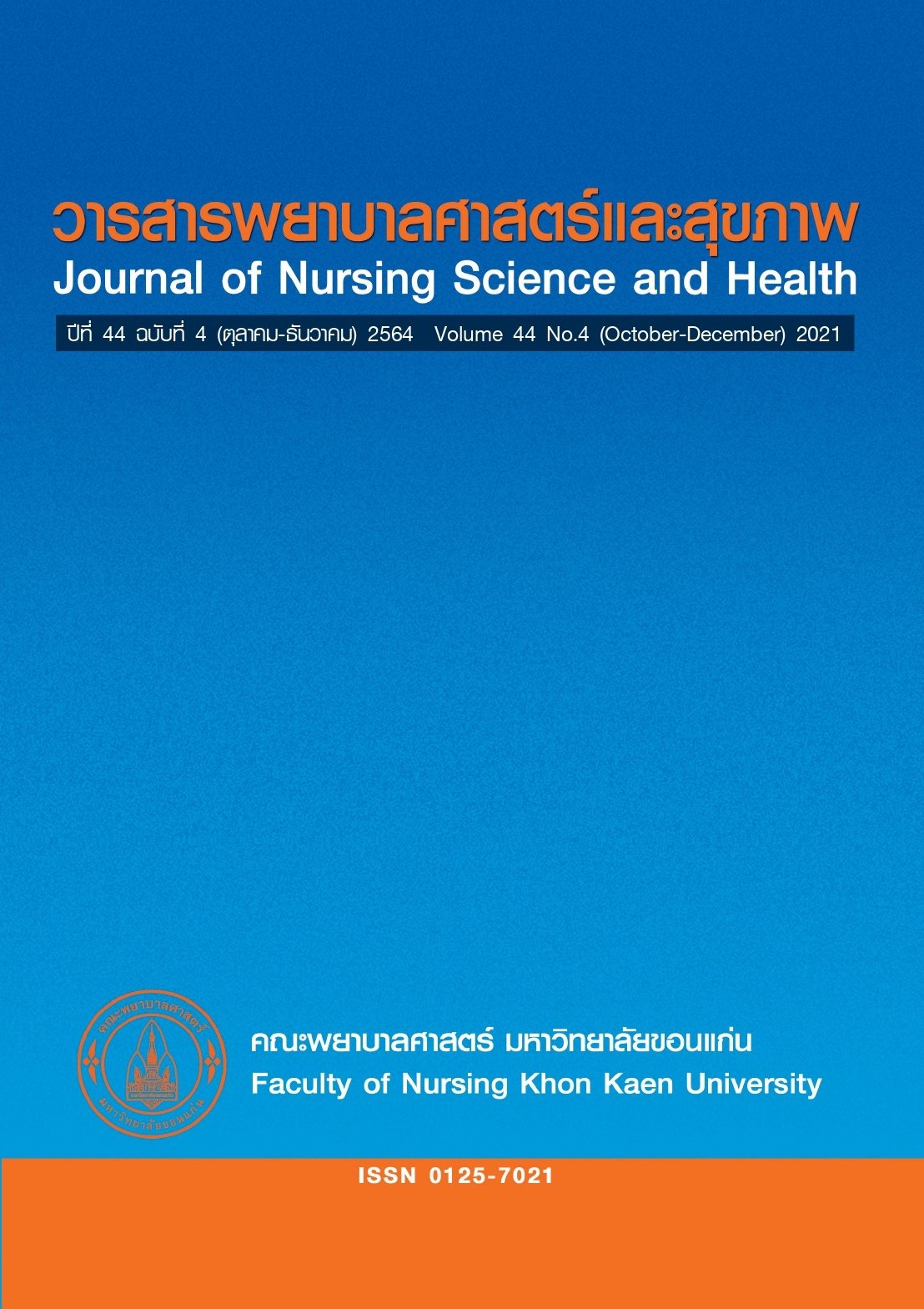ผลของโปรแกรมการจัดการตนเองร่วมกับการกระตุ้นเตือนผ่านระบบไลน์เพื่อป้องกันภาวะน้ำเกิน ในผู้ป่วยฟอกเลือดด้วยเครื่องไตเทียม
คำสำคัญ:
โปรแกรมการจัดการตนเอง, ภาวะน้ำเกิน, พฤติกรรมการจัดการตนเอง, ฟอกเลือดด้วยเครื่องไตเทียมบทคัดย่อ
การวิจัยแบบหนึ่งกลุ่มวัดผลก่อนและหลังการทดลองครั้งนี้ เพื่อศึกษาผลของโปรแกรมการจัดการตนเอง ร่วมกับการกระตุ้นเตือนผ่านระบบไลน์ต่อพฤติกรรมการป้องกันภาวะน้ำเกินและการเปลี่ยนแปลงน้ำหนักตัว ของผู้ป่วยไตเรื้อรังที่รับการฟอกเลือดด้วยเครื่องไตเทียม ณ หน่วยไตและไตเทียม โรงพยาบาลศรีนครินทร์ มหาวิทยาลัยขอนแก่น ผู้วิจัยเลือกกลุ่มตัวอย่างตามคุณสมบัติที่กำหนดและสุ่มเลือกกลุ่มตัวอย่างจำนวน 20 ราย ใช้ระยะเวลาในการศึกษา 8 สัปดาห์โดยใช้โปรแกรมการจัดการตนเองที่พัฒนาขึ้นจากกรอบแนวคิดการจัดการ ตนเองของนงลักษณ์เมธากาญจนศักดิ์(Methakanjanasak, 2005) มาใช้ในการส่งเสริมการจัดการตนเอง เพื่อป้องกันการเกิดภาวะน้ำเกิน เครื่องมือวิจัยได้ผ่านการตรวจสอบคุณภาพโดยผู้ทรงคุณวุฒิก่อนนำใช้ วิเคราะห์ข้อมูลโดยใช้สถิติเชิงพรรณาและ Repeated Measures ANOVA
ผลการศึกษาพบว่าค่าเฉลี่ยคะแนนพฤติกรรมการจัดการตนเองเพื่อป้องกันภาวะน้ำเกินของกลุ่มตัวอย่าง ทั้งโดยรวมและรายด้านภายหลังได้รับโปรแกรมการจัดการตนเองเพื่อป้องกันภาวะน้ำเกินดีกว่าก่อนได้รับโปรแกรม อย่างมีนัยสำคัญ (p < 0.05) ยกเว้นคะแนนเฉลี่ยพฤติกรรมด้านการควบคุมน้ำหลังได้รับโปรแกรมสัปดาห์ที่ 4 ไม่แตกต่างจากก่อนได้รับโปรแกรม หลังได้รับโปรแกรมการจัดการตนเองพบว่าภาวะน้ำเกินในกลุ่มตัวอย่าง เกิดขึ้นต่ำกว่าก่อนได้รับโปรแกรม โดยพบว่ามีค่าเฉลี่ยน้ำหนักตัวที่เพิ่มขึ้นระหว่างวันฟอกเลือดลดลงอย่าง มีนัยสำคัญ (F=35.569, p < 0.001) ซึ่งแสดงให้เห็นว่าโปรแกรมการจัดการตนเองนี้สามารถเพิ่มทักษะและ ส่งเสริมการจัดการตนเองเพื่อป้องกันภาวะน้ำเกินของผู้ป่วยไตเรื้อรังที่รับการบำบัดทดแทนไตโดยการฟอกเลือด ด้วยเครื่องไตเทียมได้และเห็นควรที่จะนำไปปรับใช้ในการดูแลผู้ป่วยเพื่อส่งผลต่อคุณภาพชีวิตที่ดีของผู้ป่วย ที่ได้รับการบำบัดทดแทนไตโดยการฟอกเลือดด้วยเครื่องไตเทียมต่อไป คำสำคัญ: โปรแกรมการจัดการตนเอง ภาวะน้ำเกิน พฤติกรรมการจัดการตนเอง ฟอกเลือดด้วยเครื่องไตเทียม
เอกสารอ้างอิง
The Nephrology Society of Thailand. Hemodialysis clinical practice recommendation 2014. Bangkok: The society; 2014. (in Thai)
Sukdaeng N. Effect of nursing care program based on theory of goal attainment on volume overload control behaviors in patients with renal disease receiving hemodialysis. [Thesis]. Songkhla: Prince of Songkhla Univ; 2013. (in Thai)
Wongsaree C, Kritiyawan J. An intensive educational program on therapeutic volume overload for end stage chronic renal disease patients receiving hemodialysis: Hemodialysis nurses’ roles. HCU Journal 2017; 21(41): 137-50. (in Thai)
Lindberg M, Wikström B, Lindberg P. A behavioural nursing intervention for reduced fluid overload in haemodialysis patients. Initial results of acceptability, feasibility and efficacy. Journal of Nursing and Healthcare of Chronic Illness 2011; 3(2): 87-98.
Wong MM, McCullough KP, Bieber BA, Bommer J, Hecking M, Levin NW, et al. Interdialytic weight gain: Trends, predictors, and associated outcomes in the international dialysis outcomes and practice patterns study (DOPPS). American Journal of Kidney Diseases 2017; 69(3): 367-79.
San Miguel S. Haemodialysis dry weight assessment: A literature review. Renal Society of Australasia Journal 2011; 6(1): 19-24.
Hecking M, Moissl U, Genser B, Rayner H, Dasgupta I, Stuard S, et al. Greater fluid overload and lower interdialytic weight gain are independently associated with mortality in a large international hemodialysis population. Nephrology Dialysis Transplantation 2018; 33(10): 1832-42.
NerbassFB, Morais JG, Santos RG, Krüger TS, Koene TT, LuzFilho HA, et al. Factors related to interdialytic weight gain in hemodialysis patients. Brazilian Journal of Nephrology 2011; 33(3): 300-5.
Tonsawan P, Sirivong T, Anusri J, Reungjui S, editors. Hemodialysis: Advance practice. Khon Kaen: Khon Kaen Univ; 2013. (in Thai)
Zoccali C, Torino C, Tripepi R, Tripepi G, D’Arrigo G, Postorino M, et al. Lung US in CKD working group. Pulmonary congestion predicts cardiac events and mortality in ESRD. Journal of the American Society of Nephrology 2013; 24(4): 639-46.
C a pli n B, Kumar S, Davenport A. Patients' perspective of haemodialysis-associated symptoms Nephrology Dialysis Transplantation 2011; 26(8): 2656-63.
Wongsree C, Assalee R. Experience of using social support in end stage renal disease patients receiving hemodialysis. Thai Red Cross Nursing Journal 2016; 9(2): 132-44. (in Thai)
Janthapet Y. Effect of illness representation program on volume overload control among patients receiving hemodialysis in Thatpanom Crown Prince hospital, Nakornpanom province. [An independent study report]. Khon Kaen: Khon Kaen Univ; 2013. (in Thai)
Kara B. Health beliefs related to salt-restricted diet in patients on hemodialysis: Psychometric evaluation of the Turkish version of the beliefs about dietary compliance scale. J Transcult Nurs 2014; 5(3): 256-64.
Neumann CL, Wagner F, Menne J, Brockes C, Schmidt-Weitmann S, Rieken EM, et al. Body weight telemetry is useful to reduce interdialytic weight gain in patients with end-stage renal failure on hemodialysis. Telemedicine and e-health 2013;19(6): 480-6.
Kugler C, Maeding I, Russell CL. Non-adherence in patients on chronic hemodialysis: An international comparison study. Journal of Nephrology 2011;2 4(3): 366.
Suesoom R. Effect of self-efficacy promotion on a fluid control program on the fluid control behaviors and body weight changes in end stage renal disease patients undergoing hemodialysis. [Thesis]. Pathumthani: Rangsit Univ; 2017. (in Thai)
Kittirakpanya W, Samartkit N, Masingboon K. Impacts of the co-application of self-management and clinical management programe on management behaviour, increased weight and intradialytic hypotension in chronic kidney disease patients treated with haemodialysis. Thai Journal of Nursing Council 2013; 28(2): 109-22. (in Thai)
Y i n g y a u n K, Methakanjanasak N. Self-management telehealth innovation for patients with diabetes mellitus type 2 with dyslipidemia. Srinagarind Medical Journal 2016; 31(6): 365-71. (in Thai)
Petchai T, Mingkaeo S, Nonthapha Y, Kumthong W, HomrachP, Piyalungka A, et al. The effectiveness of self-management on fluid overload management for chronic kidney disease patients with hemodialysis at Somdej Phranangchaosirikit Hospital. Royal Thai Navy Medical Journal 2018; 45(1): 106-20. (in Thai)
Methakanjanasak N. Self-management of end stage renal disease patient receiving hemodialysis [dissertation]. Chiang Mai: Chiang Mai Univ; 2005. (in Thai)
Nakhornriab S, Wattanakitkrileart D, Charoenkitkarn V, Chotikanuchit S, Vanijja V. The effectiveness of mobile application on medication adherence in patients with stroke. Nursing Science Journal of Thailand 2017; 35(3): 58-69. (in Thai)
Bashi N, Fatehi F, Fallah M, Walters D, Karunanithi M. Self-management education through mHealth: Review of strategies and structures. JMIR Mhealth Uhealth 2018; 6(10): 112-33.
Jirawattanakul A. Statistics for health science research. Bangkok: Wittayaphat; 2015. (in Thai)
Howren MB, Kellerman QD, Hillis SL, Cvengros J, Lawton W, Christensen AJ, et al. Effect of a behavioral self-regulation intervention on patient adherence to fluid-intake restrictions in hemodialysis: A randomized controlled trial. Annals of Behavioral Medicine 2016; 50(2): 167-76.
Griva K, Nandakumar M, Jo-an HN, Lam KF, McBain H, Newman SP, et al. Hemodialysis self-management intervention randomized trial (HED-SMART): A practical low-intensity intervention to improve adherence and clinical markers in patients receiving hemodialysis. American Journal of Kidney Diseases 2018; 71(3): 371-81.
Welch JL, Astroth KS, Perkins SM, Johnson CS, Connelly K, Siek KA, et al. Using a mobile application to self‐monitor diet and fluid intake among adults receiving hemodialysis. Res Nurs Health 2013; 36(3): 284-98.
ดาวน์โหลด
เผยแพร่แล้ว
รูปแบบการอ้างอิง
ฉบับ
ประเภทบทความ
สัญญาอนุญาต
วารสารพยาบาลศาสตร์และสุขภาพเป็นเจ้าของลิขสิทธิ์ในการเผยแพร่ผลงานที่ตีพิมพ์ห้ามผู้ใดนำบทความที่ได้รับการตีพิมพ์ในวารสารพยาบาลศาสตร์และสุขภาพไปเผยแพร่ในลักษณะต่าง ๆ ดังนี้ การนำบทความไปเผยแพร่ออนไลน์ การถ่ายเอกสารบทความเพื่อกิจกรรมที่ไม่ใช่การเรียนการสอน การส่งบทความไปตีพิมพ์เผยแพร่ที่อื่น ยกเว้นเสียแต่ได้รับอนุญาตจากวารสารพยาบาลศาสตร์และสุขภาพ



